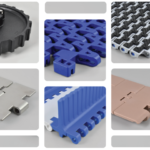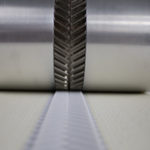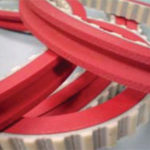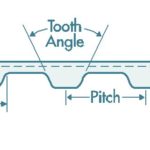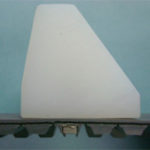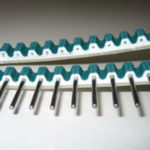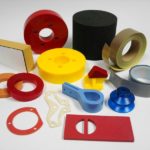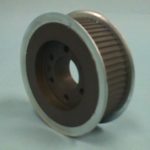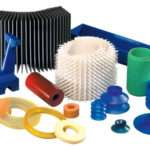
Selecting the Best Conveyor
You know you need a conveyor, but how do you choose the right one?
According to Machine Desgin:
“Industries such as pharmaceuticals, plastics and rubber, and food, routinely need to move bulk materials. How that material gets moved is vitally important to factory efficiency. So when specifying a conveyor system, engineers designing plants and processes should be familiar with the variety of options they have.
“Here are the main parameters, benefits, and disadvantages of four major types of conveyors.
Flexible-screw conveyors
“Flexible-screw conveyors are often the simplest and least expensive for moving a variety of materials at up to 40 tons/hr over distances up to 65 ft. If materials need to travel farther, several such conveyors can be linked together.
“These conveyors consist of a stainless or heat-treated and temperedcarbon steel screw that rotates within an ultrahigh-molecular-weight-polyethylene food-grade tube. For most applications, the spiral has a round cross section but a flat or profiled version can also be used for fine, cohesive, and easily smeared materials. The term “flexible” refers to the fact that these conveyors can be curved to some extent, depending on its diameter. This lets users route the conveyor around obstacles. Normally, using only one continuous curve is recommended. This type of conveyor is well suited for powdered, granular, and flaked materials with a bulk density up to 150 lb/ft3.
“Flexible-screw conveyors are designed to operate when full of material. Running empty leads to excessive noise and wear. (Although flexible spiral conveyors should run full, they can be emptied at the end of an operation or shift by removing an end bung and running the conveyor in reverse at a reduced speed if necessary.) It is also not recommended that these conveyors be used to move batches or large slugs of material. Instead, they are best used to move materials from storage or bag-tip station to a weigh hopper or vessel. For example, they are ideal for maintaining a constant head of material in packing-machine hoppers by gently filling rather than dumping in batches. Because material flow is constant, flexible spiral conveyors deliver accurate, highly repeatable batches if controlled by a simple timing switch. And having a head of material in a feed hopper helps with the elevation of material upon start-up of the conveyor by consistently sending the same amount of material into the conveyor inlet. This lets the conveyor operate more efficiently and makes batches more accurate.
“The main benefit of flexible-screw conveyors is their inherent simplicity. This leads to low initial cost, quick installation, and low maintenance. Food and dairy versions, for example, can be safely stripped down in minutes for cleaning.
“Wear is only a problem with abrasive products. Life with other materials is almost indefinite. Tubes and screws are easily replaced. One of the latest developments is abrasion resistant rubber tubes for such applications as aggregates, sand, cement, and glass cullet.
Aeromechanical conveyors
“A more descriptive name for an aeromechanical conveyor (AMCs) is rope-and-disk conveyor. This is because AMCs consist of several evenly spaced polyurethane disks attached to a wire rope. The rope and disks travel quickly around a continuous loop within parallel steel tubes. Housings enclose both ends of the conveyor, and the rope and disks run from one tube to the other around a pair of sprockets. One sprocket drives the rope and disks while the other tensions the rope. The speed of the disks creates an air stream that fluidizes and entrains material until it is centrifugally ejected at the outlet. This lets AMCs move materials from 10 to 85 ft at up to 120 tons/hr with little power, minimal product degradation, and virtually no separation of mixtures.
“AMCs are effectively mechanical vacuum conveying and should not be confused with drag-link conveyors which are slow-moving, heavyduty devices in which cast-iron disks linked by rods or chains scrape material along inside a tube.
“Over the years, the AMC has proven to be a cost-efficient and dustfree way to move materials, which eliminates the need for filtration. AMCs can move batches and operate at any angle (including vertical) without sacrificing capacity or contaminant- free delivery. They can also be supplied with access panels to make cleaning easier.
“Besides straight-line operation, AMCs are available in several aroundthe- corner configurations. In addition to free-flowing powders such as acrylics, flour, and carbon black, AMCs can move difficult materials such as titanium dioxide. They also have no problems moving granules, flakes, or chips.
“A major benefit of this type of conveyor is that degradation to the material is almost negligible. This is because AMCs create a moving current of air in which the material is carried, similar to the effect of a vacuum or pneumatic system. However, unlike vacuums or pneumatics, AMCs do not need a cyclone or filter to separate materials from the air. This saves money and reduces maintenance and environmental issues because the air carrying the material is recycled.
“AMCs should always be started empty, then fed or loaded gradually. With free-flowing materials, this can be done with a simple slide gate. In other cases, a controlled feed device, such as a rotary valve or flexible screw conveyor, should do the trick.
“One disadvantage of AMCs is that maintenance costs can range from moderate to high. Rope tension needs regular adjustment during allimportant start-up periods and then checked periodically. Rope life depends upon on conveyor length, number of starts and stops, loading, and whether routine inspection and tensioning is properly performed. Regular maintenance can be minimized by selecting an AMC with rope-tension monitoring and adjustment.
“Despite this maintenance drawback, properly maintained AMCs have lasted 14 years and more despite arduous duty. Vacuum conveyors Vacuum conveyors are the first choice when material must be moved over long distances and torturous routes. They are usually limited to throughputs of around 10 tons/hr at distances up to 330 ft. Vacuum conveyors use air to move materials through a pipeline. They are easy to route, have few moving parts, are dusttight in operation, and leave minimum residue in emptied storage containers and transport tubes. Because they suck in air, vacuum conveyors are often used to move toxic and otherwise hazardous materials because the tubes contain all materials and minimize release of them to the atmosphere.
“Either an exhauster or fan at the receiving end of the system provides the motive force. For low-capacity motion, air-powered Venturi systems offer low capital costs and are not as expensive to operate as many have been led to believe. And reverse-jet self-cleaning filters clean the air and return it to the atmosphere after use. The filters also reduce maintenance and minimize product loss.
“Vacuum systems are normally the only choice when it’s necessary to suck material out of bags or other open-top containers, such as kegs and drums. These conveyors are also ideal for pulling materials from several sources.
Pneumatic conveyors
“Pneumatic conveyors are probably the most versatile of all, but they are also the most expensive. They have virtually no limit on capacity, product type, distance, or routing. Lean-phase versions, in which the ratio of material to air is low, can move mountains of material. Lean-phase conveyors typically move 1 lb of air for every pound of materiel. Pressure drops across such conveyors range between 1.5 to 20 psig and air velocity is between 60 and 75 fpm with the entrained material traveling at about 70% of that speed due to the slip factor.
“Dense-phase or plug-flow versions can move slugs of material at lower speeds with minimal degradation. They move about 100 lb of material for every pound of air, but air pressure can be as high as 100 psig. Slugs move between 10 and 30 fps. Positive-pressure models are generally used to move materials from one place to one or several different destinations. They are normally used for major tasks, such as quickly emptying road and rail tankers into silos or moving material from silos to large-scale production processes. Capacities of up to 100 tons/hr are not unusual.
“The two main disadvantages of pneumatic conveyors are a relatively high initial installation cost and the amount of filtration required. The high cost is due to the need for an expensive blower or compressor, as well as larger diameter (up to 6 in.), pressure-tested pipe, supporting the larger pipes, and filtering the large volume of air used. As with vacuum conveyors, self-cleaning reverse-jet filters are a big help in reducing maintenance. Maintenance is needed to ensure these systems are leak-free for best efficiency and, above all, to avoid associated health and environmental issues leaks cause.
Other conveyors
“There are several other types of conveyors, including:
“Rigid-screw conveyors. Beware of the seals and bearings.
“Bucket elevators. This type of conveyor is ideal for most delicate products, but generally not for those that are dusty.
“Flat-belt conveyors. These are mainly used in quarries and mines.
“Vibratory feeders. Good for distances of 6 ft or less.
“Air slides. Well suited for moving dense materials downhill.
“In some applications, a mix of conveyor types is appropriate. For example, short, easy-to-clean flexible- screw conveyors are often used to consistently feed material to a longdistance AMC.
“In selecting a conveyor, the key is to find a supplier you have confidence in and are comfortable with. The supplier should provide a performance guarantee for the material you will be moving. After that, it comes down to the usual commercial considerations of price and delivery. Normally, installing a conveyor is part of a larger project. But heath, safety, and environmental benefits usually outweigh monetary issues. Nevertheless, the conveyor has to be the right one for the job.
WHAT ENGINEERS SHOULD KNOW
“Before selecting a conveyor, designers should be familiar with their speci c application. Answering these questions will help them select the right conveyor:
- “What product or material will be moved?
- “What are its bulk densities?
- “What is its moisture content, average particle size, and temperature?
- “Is the material or product likely to change in any way in the future?
- “From what is the product being moved (for example, from a silo, bulk bag, or bag-tip station)?
- “To what is the product being moved (such as a mixer, sifter, mill, or reactor)?
- “If it’s going to a reactor of any type, is there any steam, gas, or solvents given o that might enter the conveyor?
- “How far will the conveyor travel horizontally?
- “How far will it travel vertically?
- “What route will the conveyor take (such as inside, outside, bends, total number of bends)?
- “Will the conveyor move a constant a stream of material or preweighed batches on load cells?
- “At what rate is material being moved in pounds per hour or batch size over a given time?
- “How long will the conveyor operate each day? How many days per week?
- “Should the conveyor deliver material in a homogenous manner, such as adding akes to a liquid to make a lumpfree paste?
- “If the product is a mixture, is it essential to maintain the integrity of the mix?
- “Is the material fragile? How important is it to minimize damage during conveying?
- “What other equipment is needed (such as a bag-tip station, bulk-bag discharger. or receiver hopper)?
- “Will the conveyor operate in a dusty or otherwise hazardous area (i.e., will NEMA-rated explosionproof motors and other such equipment be required)?
- “Is the conveyor manufacturer also supplying the control panel, level sensors, and other accessories?
- “Will the conveyor be readily accessible for maintenance?
- “How long is the conveyor expected to run between services?”
